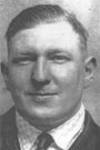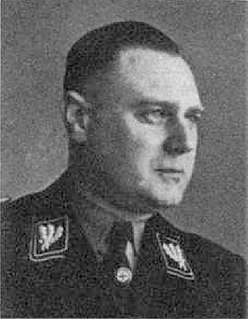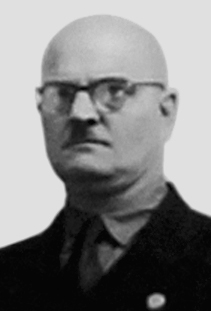 W
WThe T4-Gutachter were medical experts who were employed by the Zentraldienststelle-T4 to organize and carry out the Action T4 euthanasia program in Nazi Germany. Based on reporting forms with information about the mentally ill and disabled, they decided who would be killed in "euthanasia" centers. An internal document from the organization shows a list of 40 physicians who were among those who worked for Action T4.
 W
WErich Bauer, sometimes referred to as "Gasmeister", was a low-level commander in the SS of Nazi Germany and a Holocaust perpetrator. He participated in Action T4 program and later in Operation Reinhard, when he was a gas chamber operator at Sobibór extermination camp.
 W
WRudolf Beckmann was a German SS-Oberscharführer in the Sobibor extermination camp. He was stabbed to death during the uprising in Sobibor by inmates. Beckmann was a member of the NSDAP and the SS. Nothing is known about his early life.
 W
WWerner Blankenburg was a high official in Nazi Germany who led the commission of numerous crimes against humanity. As section head in Hitler's chancellery, he was one of the persons mainly responsible for the Aktion T4 euthanasia program, the annihilation of the Polish Jews in "Aktion Reinhard", and the experiments with castration by X-rays in the Auschwitz-Birkenau concentration camp.
 W
WHeinz Kurt Bolender was an SS sergeant during the Nazi era. In 1942, he operated the gas chambers at Sobibór extermination camp, perpetrating acts of genocide against Jews and Romani people during Operation Reinhard. After the war, Bolender was recognized in 1961 while working under a false identity as a doorman at a nightclub in Germany, and subsequently accused in 1965 of personally murdering at least 360 Jewish inmates and assisting in the murder of 86,000 more at Sobibór. He committed suicide in prison two months prior to the end of the trial.
 W
WPhilipp Bouhler was a German senior Nazi Party functionary who was both a Reichsleiter and Chief of the Chancellery of the Führer of the NSDAP. He was also the SS official responsible for the Aktion T4 euthanasia program that killed more than 250,000 disabled adults and children in Nazi Germany, as well as co-initiator of Aktion 14f13, also called "Sonderbehandlung", that killed 15,000–20,000 concentration camp prisoners.
 W
WViktor Hermann Brack was a member of the Schutzstaffel (SS) and a convicted Nazi war criminal, who was one of the prominent organisers of the euthanasia programme Action T4; this Nazi initiative resulted in the systematic murder of over 70,000 disabled German and Austrian people. He held various positions of responsibility in Hitler's Chancellery in Berlin. Following his role in the T4 programme, Brack was one of the men identified as responsible for the gassing of Jews in extermination camps, having conferred with Odilo Globočnik about its use in the practical implementation of the Final Solution. Brack was sentenced to death in 1947 and executed by hanging in 1948.
 W
WKarl Brandt was a German physician and Schutzstaffel (SS) officer in Nazi Germany. Trained in surgery, Brandt joined the Nazi Party in 1932 and became Adolf Hitler's escort doctor in August 1934. A member of Hitler's inner circle at the Berghof, he was selected by Philipp Bouhler, the head of Hitler's Chancellery, to administer the Aktion T4 euthanasia program. Brandt was later appointed the Reich Commissioner of Sanitation and Health. Accused of involvement in human experimentation and other war crimes, Brandt was indicted in late 1946 and faced trial before a U.S. military tribunal along with 22 others in United States of America v. Karl Brandt, et al. He was convicted, sentenced to death, and later hanged on 2 June 1948.
 W
WPaul Bredow was an SS sergeant and a Holocaust perpetrator. He served at Treblinka extermination camp during the Operation Reinhard phase of the Holocaust in Poland.
 W
WLeonardo Conti was the Reich Health Leader in Nazi Germany. The killing of many Germans who were of "unsound mind" is attributed to his leadership.
 W
WIrmfried Eberl was an Austrian psychiatrist and medical director of the euthanasia institutes in Brandenburg and Bernburg, who helped set up and was the first commandant of the Treblinka extermination camp where he worked as SS-Obersturmführer from 11 July 1942 until his dismissal on 26 August 1942. He was arrested after the end of the war in January 1948. Eberl hanged himself the following month to avoid trial.
 W
WKurt Hubert Franz was an SS officer and one of the commanders of the Treblinka extermination camp. Because of this, Franz was one of the major perpetrators of genocide during the Holocaust. Sentenced to life imprisonment in the Treblinka Trials in 1965, he was eventually released in 1993.
 W
WKarl August Wilhelm Frenzel was an SS noncommissioned officer in Sobibor extermination camp.
 W
WErich Fuchs was an SS functionary who worked for the Action T4 euthanasia program, and for the Operation Reinhard phase of the Holocaust.
 W
WErnst-Robert Grawitz was a German physician and an SS functionary during the Nazi era.
 W
WLorenz Hackenholt was a member of the Schutzstaffel (SS) with the rank of Hauptscharführer. During World War II Hackenholt built and operated the gas chamber at the Bełżec extermination camp in occupied Poland. In so doing, he personally carried out the murder of hundreds of thousands of people.
 W
WGottlieb Hering was an SS commander of Nazi Germany. He served in Action T4 and later as the second and last commandant of Bełżec extermination camp during Operation Reinhard. Hering directly perpetrated the genocide of Jews and other peoples during The Holocaust.
 W
WWerner Heyde was a German psychiatrist. He was one of the main organizers of Nazi Germany's T-4 Euthanasia Program.
 W
WJosef Hirtreiter was an SS functionary of Nazi Germany and a Holocaust perpetrator who worked at Treblinka extermination camp during the Operation Reinhard phase of the Holocaust in Poland.
 W
WIrmgard Huber (1901–1983) was the head nurse of Germany's Hadamar Clinic, a psychiatric facility. Beginning in late 1939, it was operated as one of six major centers for Action T4, a secret sterilization and euthanasia program in Nazi Germany. Nearly 15,000 German citizens were killed here, including thousands of children.
 W
WAlfred Ittner was an SS functionary of Nazi Germany who served at the Sobibór extermination camp.
 W
WErich Koch was a Gauleiter of the Nazi Party (NSDAP) in East Prussia from 1 October 1928 until 1945. Between 1941 and 1945 he was Chief of Civil Administration of Bezirk Bialystok. During this period, he was also the Reichskommissar in Reichskommissariat Ukraine from September 1941 until August 1944 and in Reichskommissariat Ostland from September 1944. After the Second World War, Koch stood trial in Poland and was convicted in 1959 of war crimes and sentenced to death. The sentence was never carried out and Koch died of natural causes in his cell at the Barczewo prison on the 12 November 1986.
 W
WKarl Heinrich Wilhelm Koppe was a German Nazi commander. He was responsible for numerous atrocities against Poles and Jews in Reichsgau Wartheland and the General Government during the German occupation of Poland in World War II.
 W
WErwin Hermann Lambert was a perpetrator of the Holocaust. In profession, he was a master mason, building trades foreman, Nazi Party member and member of the Schutzstaffel with the rank of SS-Unterscharführer (corporal). He supervised construction of the gas chambers for the Action T4 euthanasia program at Hartheim, Sonnenstein, Bernburg and Hadamar, and then at Sobibór and Treblinka extermination camps during Operation Reinhard. He specialized in building larger gas chambers that killed more people than previous efforts in the extermination program.
 W
WSS-Unterscharführer Willi Bruno Mentz was a member of the German SS in World War II and a Holocaust perpetrator who worked at Treblinka extermination camp during the Operation Reinhard phase of the Holocaust in Poland. Mentz was known as "Frankenstein" at the camp.
 W
WHermann Michel (help·info), sometimes referred to as "Preacher", was a Nazi and SS-Oberscharführer. During World War II, he participated in the extermination of Jews at the Sobibór extermination camp during the Nazi operation known as Aktion Reinhard. According to the Majdanek Museum, a different person named Hermann Michel, born 23.04.1912 in Passau, served at Buchenwald, Majdanek and Sachsenhausen. This person was killed in 1944.
 W
WAugust Wilhelm Miete was an SS functionary of Nazi Germany. He worked at the Grafeneck and Hadamar Euthanasia Centres, and then at Treblinka extermination camp. Miete was arrested in 1960 and tried in West Germany for participating in the mass murder of at least 300,000 people; in 1965, he was found guilty and sentenced to the maximum penalty, life imprisonment.
 W
WHermann Paul Nitsche was a German psychiatrist known for his expert endorsement of the Third Reich's euthanasia authorization and who later headed the Medical Office of the T-4 Euthanasia Program.
 W
WJosef Oberhauser was a low-ranking German SS commander during the Nazi era. He participated in Action T4 and Operation Reinhard. Oberhauser was the only person to be successfully convicted of crimes committed at the Bełżec extermination camp. He was charged with 450,000 counts of accessory to murder and sentenced to 4.5 years imprisonment during the Belzec Trial of 1964.
 W
WFranz Karl Reichleitner was an Austrian member in the SS of Nazi Germany who participated in Operation Reinhard during the Holocaust. Reichleitner served as the second and last commandant of Sobibór extermination camp from 1 September 1942 until the camp's closure on or about 17 October 1943. As the commanding officer of the camp, Franz Reichleitner directly perpetrated the genocide of Jews.
 W
WFritz Schmidt was a low-ranking commander in the Schutzstaffel of Nazi Germany and Holocaust perpetrator during World War II. He served as a guard and driver at the Sonnenstein Euthanasia Centre and at the Bernburg Euthanasia Centre in 1940–41 with the rank of Unterscharführer. Schmidt was transferred to Treblinka extermination camp along with other gassing specialists in 1942. At Treblinka, he was in charge of the engine room feeding exhaust to the gas chambers.
 W
WWalter Schultze was a German physician and Reichsdozentenführer in Nazi Germany between 1935 and 1943.
 W
WOtto Stadie was a German nurse and member of the Action T4, the Nazi forced euthanasia programme. During the Holocaust in occupied Poland he kept the register of stolen gold and diamonds at the Treblinka extermination camp. He was convicted in the first Treblinka trial of 1968.
 W
WFranz Paul Stangl was an Austrian-born police officer and commandant of the Nazi extermination camps Sobibor and Treblinka. Stangl, an employee of the T-4 Euthanasia Program and an SS commander in Nazi Germany, became commandant of the camps during the Operation Reinhard phase of the Holocaust. He worked for Volkswagen do Brasil and was arrested in Brazil in 1967, extradited to West Germany and tried for the mass murder of 1 million people. In 1970, he was found guilty and sentenced to the maximum penalty, life imprisonment. He died of heart failure six months later.
 W
WSS-Sturmbannführer Karl Steubl, Steubel, or Steibel was a Nazi, perpetrator of euthanasia programme dubbed Action T4, and commander of transportation at the Sobibór extermination camp during Operation Reinhard, the most deadly phase of the Holocaust. Arrested after the war in Europe ended, Steubl committed suicide in Linz, Austria.
 W
WFranz Suchomel was a Sudeten German Nazi war criminal. He participated in the Action T4 euthanasia program, in Operation Reinhard, and the Einsatzgruppen actions in the Adriatic operational zone. He was convicted at the Treblinka trials in September 1965 and spent four years in prison.
 W
WGerhard Wagner was the first Reich Doctors' Leader (Reichsärzteführer) in the time of Nazi Germany.
 W
WGustav Franz Wagner was an Austrian member of the SS with the rank of Staff sergeant (Oberscharführer). Wagner was a deputy commander of Sobibor extermination camp in German-occupied Poland, where 200,000-250,000 Jews were gassed during Operation Reinhard. Due to his brutality, he was known as "The Beast" and "Wolf".
 W
WAlbert Widmann was an SS officer and German chemist who worked for the Action T4 euthanasia program during the regime of Nazi Germany. He was convicted in two separate trials in the West German courts in the 1960s for his criminal activities during World War II.
 W
WChristian Wirth was a German SS officer and Holocaust perpetrator who was one of the leading architects of the program to exterminate the Jewish people of Poland, known as Operation Reinhard. His nicknames included Christian the Cruel and The Wild Christian.
 W
WSS-Oberscharführer Franz Wolf was a German Nazi senior squad leader serving with the Action T4 forced euthanasia program, and later, at the Sobibór extermination camp in occupied Poland during the most deadly phase of the Holocaust, codenamed Operation Reinhard. Leading a normal life in West Germany for the next twenty years, along with thousands of war criminals protected by Konrad Adenauer, Wolf was arrested in 1964, and indicted during the Sobibór trial with participating in the murder of 115,000 Jews. On 20 December 1966, the court in Hagen sentenced him to eight years in prison for taking part in the mass murder of "at least 39,000 Jews".
 W
WErnst Zierke was a low-ranking member in the SS who took part in the Action T4 forced euthanasia program in Nazi Germany, and after the invasion of Poland worked at Bełżec and Sobibór extermination camps during Operation Reinhard. Zierke helped to perpetrate the Holocaust. He was charged with being an accessory to the murder of 360,000 Jews at death camps, acquitted twice, in the Belzec and Sobibór trials of 1965 on grounds of acting under duress and set free.